|
|
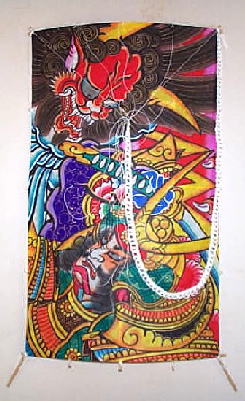
RASHOMON
"Rashomon" is the name of a gate at Kyoto, where this
dramatic scene took place. Long, long ago, there was a rumour that a
demon appeared at the gate,and people were very frightened. One rainy
day, Minamoto-no Raiko sent one of his most trusted and valued retainers,
Watanabe-no Tsuna to set up a signboard there. Having rode alone to the
gate, but wearing his armour, Tsuna had just finished the sign when the
demon appeared. It came at Tsuna from the top of the gate, wreathed in
black clouds, attacking him and grasping his helmet. Tsuna cut the
demons' arm off, and brought it back to his home.
|
|
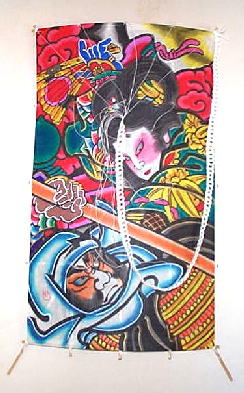
GOJO OHASHI
"Gojo Ohashi" is the name of a bridge at Kyoto. A Buddhist
priest named Benkei went to the bridge every day to challenge SAMURAI
warriors to fights. He had won 999 swords from them, and wanted 1000.
One day a handsome boy, playing a bamboo flute, came to the bridge with
a very beautiful sword. Benkei challenged him to a fight, as usual, with
his pole sword. The boy dodged the pole sword every time, one moment he
would be behind Benkei, the next moment he was on the parapet. Finally
Benkei was beaten. The name of the boy was Ushiwaka-maru, the childhood
name of Yoshitsune. After this battle, Benkei became a faithful retainer
of Yoshitsune.
|
|
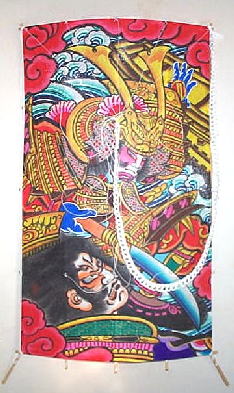
YOSHITSUNE HASSOTOBI
This picture is from the long, historical, Japanese "Heike
Story". Heike (Taira family) had been at war with Genji (Minamoto
family) for a long time. Their final battle was on the sea at Dan-no-ura
in 1185. There were many boats on the sea, but Taira-no Noritsune
(Heike) found the enemy leader Minamoto-no Yoshitsune, and tried to
capture him. Yoshitsune jumped from boat to boat and escaped, and the
Taira family perished in the battle.
|
|
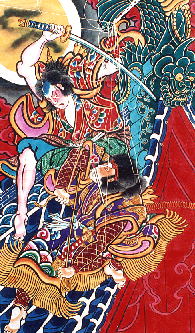
HAKKENDEN
This is a very famous long novel (106-volume) named "Nanso
Satomi Hakkenden" written by Bakin Takizawa (1767-1848) in the Edo
period. They said the novel took him 28 years to complete. Hakkenden is
performed many times at the Kabuki theaters all over Japan from the Edo
period. This is the battle between Shino Inuzuka and Genpachi Inukai on
the roof of "Horyukaku", and one of the highlight seen of the
"Hakkenden" Kabuki play.
|
|

TSUKINAMI
The Sun, Rock and Wave.
|
|
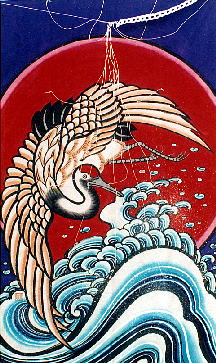
NAMIZURU
The Sun, Wave and Crane.
We Japanese believe that "Cranes" and "turtles" are
symbols of happiness and good luck. There is a saying "Cranes live
for thousand years, and turtles live for ten thousand years." For
example, Japanese believe "Pine trees", "Bamboo" and
"Plum trees" are also symbols of happiness and good luck. This
belief was introduced into Japan from China.
|
|

KUMONRYU
The Japanese letter in the red circle means Dragon, and whorls of the
black lines means the clouds.
|
|
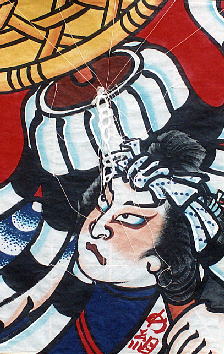
MEGUMI
He is a fireman in Edo period, and has a fireman's standard (MATOI).
|
|